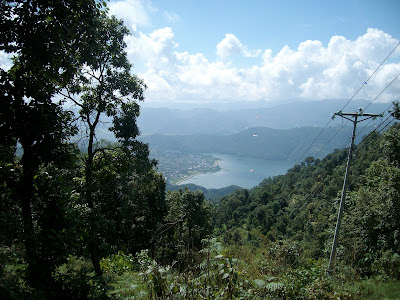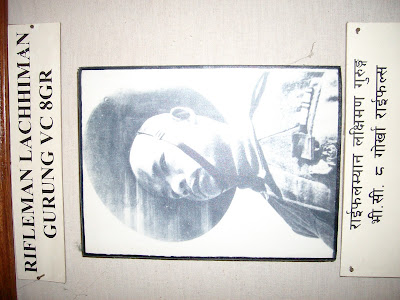This weekend we visited the city of Pokera. It is about 200km West of Kathmandu, and sits at lower altitude (and so was even warmer!)
We left in the afternoon after hospital, taking a minibus ('microbus' here) for the six hour journey through the very beautiful winding countryside, passing the Royal Beach resort where we went rafting etc on the way.
 | ||||
| View from Hotel balcony (Lake to the left of shot). The pointy mountain is called Machapuchre. At 6997m tall, it is the only mountain in Nepal which is forbidden to be climbed |
The hotel recommended Hotel ABC, which was situated in the popular Lakeside area of Pokera, so called because of it's positioning adjacent to the tranquil Prewa Tal lake. Hari, the hotel manager met us at the bus stop, and recommended the Almond Restaurant for 'the best food in Pokera'. I have to say that I was not disappointed! My ‘Almond Special Butter Chicken’ curry was delicious – very creamy tomato flavour, mild but much nicer than the standard korma in the UK! After finishing off with butter scotch ice cream, I felt a lot better after our long and bumpy journey.
 | ||||||
| Walking up Sarangkot |
On Saturday I hired a motorbike and Yan a moped and we set off to Sarangkot. This village is on top of one of the hills surrounding the lake, and offers spectacular views of the Annapurna part of the Himalaya. I walked the final half an hour up to the top, and despite the cloud covering most of the mountains (much like in Nagarkot), you could still see very far:
 |
| View from the top over Prewa Tal |
After Sarangkot, we rode around for a while before visiting the Gurkha Memorial Museum. It is situated in Pokera because of the nearby recruiting base, which still attracts hundreds of applicants for the honour of being accepted as Gurkha soldier in the British Army.
The museum is filled with memorabilia and history dating back from the days of the East India Company to the present day. The most moving contents however, are the tales of dozens of men filling the walls, most accounts record episodes of great bravery for which they were honoured, often with a VC.
 |
| The Khukuri knife, a symbol of the Gurkhas |
 |
One such account is that of Rifleman Lachhiman Gurung (above), who in 1945 whilst fighting the Japanese hurled back a grenade which fell on the edge of his trench, then immediately afterwards threw back another which landed inside the trench. When the third grenade landed just in front of him, he once again attempted to throw it back but it exploded in his hand, and he lost his fingers and was bleeding severely. With two comrades wounded in the bottom of the trench, he switched his rifle to his left hand, and maintained a steady rate of fire for over four hours as wave after wave of Japs attempted to storm his trench, which was essential for the battle. Of the 87 enemy dead, 31 lay in front of this man’s post. He was evacuated to hospital, but lost his right arm and eye. He was awarded the Victoria Cross in Delhi, and his proud elderly father was carried for 11 days by members of his village to be there. One of his sons is now an officer with the Gurkha Rifles.
There are many other stories of equal bravery and dedication, and the museum was a fitting tribute to the many Gurkhas who have fought and continue to fight for the British Army.
On Sunday we got a boat ride across the lake, and then walked half an hour up to the World Peace Pagoda (on a hill the opposite side of the lake to Sarangkot). I was very hot and had sweat dripping from my face by the time we got to the top, but it was worth it from the top. Photos to follow.








No comments:
Post a Comment